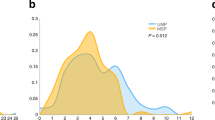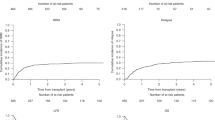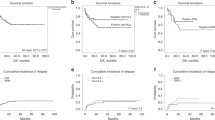Summary:
We evaluated the outcome of 63 children given haematopoietic stem cell transplantation from unrelated donors (URD-HSCT) prospectively selected using DNA high-resolution typing of both HLA class I and class II loci. Thirty patient/donor pairs (48%) were fully matched. Among the others, HSCT was performed in the presence of one (n=22), two (n=9), or three (n=2) HLA disparities. Patients had either malignant (n=46) or non-malignant (n=17) disease. In all cases, graft-versus-host disease (GVHD) prophylaxis consisted of cyclospor-in A, short-term methotrexate and pretransplant anti-thymocyte globulin. The probability of haematopoietic recovery at day 100 was 97%. Two patients experienced primary graft failure. The cumulative probability of grades III–IV acute GVHD and of extensive chronic GVHD equalled 8 and 14%, respectively. A total of 12 patients died of transplant-related complications. The probability of transplant-related mortality (TRM) at 100 and 180 days was 10 and 15%, respectively, whereas the cumulative incidence of TRM was 22%. The probability of GVHD-related mortality equalled 6% at 2.5 years. The overall and disease-free survival rates were 67 and 65%, respectively. URD-HSCT with donor selection based on high-resolution HLA typing is associated with low incidence of both severe acute GVHD and graft failure. The observed outcome is comparable to that of children transplanted from HLA-identical siblings.
This is a preview of subscription content, access via your institution
Access options
Subscribe to this journal
Receive 12 print issues and online access
$259.00 per year
only $21.58 per issue
Buy this article
- Purchase on Springer Link
- Instant access to full article PDF
Prices may be subject to local taxes which are calculated during checkout



Similar content being viewed by others
References
Sierra J, Storer B, Hansen JA et al. Transplantation of marrow from unrelated donors for treatment of high-risk acute leukemia: the effect of leukemic burden, donor HLA-matching, and marrow cell dose. Blood 1997; 89: 4226–4235.
Szydlo R, Goldman JM, Klein JP et al. Results of allogeneic bone marrow transplants for leukemia using donors other than HLA-identical siblings. J Clin Oncol 1997; 15: 1767–1777.
Leung WH, Turner V, Richardson SL et al. Effect of HLA class I or class II incompatibility in pediatric marrow transplantation from unrelated and related donors. Hum Immunol 2001; 62: 399–407.
Vogelsang GB, Hess AD . Graft-versus-host disease: new directions for a persistent problem. Blood 1994; 84: 2061–2067.
Petersdorf EW, Longton GM, Anasetti C et al. Association of HLA-C disparity with graft failure after marrow transplantation from unrelated donors. Blood 1997; 89: 1818–1823.
Petersdorf EW, Kollman C, Hurlay CK et al. Effect of HLA class II gene disparity on clinical outcome in unrelated donor haematopoietic cell transplantation for chronic myeloid leukemia: the US National Marrow Donor Program Experience. Blood 2001; 98: 2922–2929.
Rufer N, Tiercy JM, Breur-Vriesendorp B et al. Histoincompatibilities in ABDR-matched unrelated donor recipient combinations. Bone Marrow Transplant 1995; 16: 641–646.
Santamaria P, Reinsmoen NL, Lindstrom AL et al. Frequent HLA class I and DP sequence mismatches in serologically (HLA-A, HLA-B, HLA-DR) and molecularly (HLA-DRB1, HLA-DQA1, HLA-DQB1) HLA-identical unrelated bone marrow transplant pairs. Blood 1994; 83: 280–287.
Scott I, O'Shea J, Bunce M et al. Molecular typing shows a high level of HLA class I incompatibility in serologically well matched donor/patient pairs: implications for unrelated bone marrow donor selection. Blood 1998; 92: 4864–4871.
Prasad VK, Kernan NA, Heller G et al. HLA-C disparity between patients and donors matched for HLA-A, -B, and -DRB1 alleles: impact of serological vs DNA typing for HLA-A and -B loci. Biol Blood Marrow Transplant 1999; 5: 77–85.
Morishima Y, Sasazuki T, Inoko H et al. The clinical significance of human leukocyte antigen (HLA) allele compatibility in patients receiving a marrow transplant from serologically HLA-A, HLA-B, and HLA-DR matched unrelated donors. Blood 2002; 99: 4200–4206.
Sasazuki T, Juji T, Morishima Y et al. Effect of matching of class I HLA alleles on clinical outcome after transplantation of haematopoietic stem cells from an unrelated donor. N Engl J Med 1998; 339: 1177–1193.
Petersdorf EW, Gooley TA, Anasetti C et al. Optimizing outcome after unrelated marrow transplantation by comprehensive matching of HLA class I and II alleles in the donor and recipient. Blood 1998; 92: 3515–3520.
El Kassar N, Legouvello S, Joseph CM et al. High resolution HLA class I and II typing and CTLp frequency in unrelated donor transplantation: a single institution retrospective study of 69 BMTs. Bone Marrow Transplant 2001; 27: 35–43.
Speiser DE, Tiercy JM, Rufer N et al. High resolution HLA matching associated with decreased mortality after unrelated bone marrow transplantation. Blood 1996; 10: 4455–4462.
Dini G, Lanino E, Lamparelli T et al. Unrelated donor marrow transplantation initial experience of the Italian bone marrow transplant group (GITMO). Bone Marrow Transplant 1996; 17: 55–62.
Balduini CL, Noris P, Giorgiani G et al. Incompatibility for CD31 and human platelet antigens and graft-versus-host disease after bone marrow transplantation. Br J Haematol 1999; 106: 723–729.
Salvaneschi L, Perotti C, Zecca M et al. Extracorporeal photochemotherapy for treatment of acute and chronic GVHD in childhood. Transfusion 2001; 41: 1299–1305.
Locatelli F, Percivalle E, Comoli P et al. Human cytomegalovirus (HCMV) infection in paediatric patients given allogeneic bone marrow transplantation: role of early treatment of antigenaemia on patients' outcome. Br J Haematol 1994; 88: 64–71.
Glucksberg H, Storb R, Fefer A et al. Clinical manifestations of graft-versus-host disease in human recipients of marrow from HLA-matched sibling donors. Transplantation 1974; 18: 295–304.
Storb R, Prentice RL, Sullivan KM et al. Predictive factors in chronic graft-versus-host disease in patients with aplastic anemia treated by bone marrow transplantation from HLA-identical siblings. Ann Intern Med 1983; 98: 461–466.
Gooley TA, Leisenring W, Crowley J, Storer BE . Estimation of failure probabilities in the presence of competing risk: New representations of old estimators. Stat Med 1999; 18: 695–706.
Bunin N, Carston M, Wall D et al. Unrelated marrow transplantation for children with acute lymphoblastic leukemia in second remission. Blood 2002; 99: 3151–3157.
Smith FO, King R, Nelson G et al. Unrelated donor bone marrow transplantation for children with juvenile myelomono-cytic leukaemia. Br J Haematol 2002; 116: 716–724.
Guardiola P, Pasquini R, Dokal I et al. Outcome of 69 allogeneic stem cell transplantations for Fanconi anaemia using HLA-matched unrelated donors: a study on behalf of the European Group for Blood and Marrow Transplant. Blood 2000; 95: 422–429.
Oakhill A, Pamphilon DH, Potter MN et al. Unrelated donor bone marrow transplantation for children with relapsed acute lymphoblastic leukaemia in second complete remission. Br J Haematol 1996; 94: 574–578.
Hongeng S, Krance RA, Bowman LC et al. Outcomes of transplantation with matched-sibling and unrelated-donor bone marrow in children with leukaemia. Lancet 1997; 350: 767–771.
Madrigal JA, Scott I, Arguello R et al. Factors influencing the outcome of bone marrow transplants using unrelated donors. Immunol Rev 1997; 157: 153–166.
Davies SM, Kollman C, Anasetti C et al. Engraftment and survival after unrelated-donor bone marrow transplantation: a report from the national marrow donor program. Blood 2000; 96: 4096–4102.
Ferrara GB, Bacigalupo A, Lamparelli T et al. Bone marrow transplantation from unrelated donors: the impact of mismatches with substitutions at position 116 of the human leukocyte antigen class I heavy chain. Blood 2001; 98: 3150–3155.
Bacigalupo A, Lamparelli T, Bruzzi P et al. Antithymocyte globulin for graft-versus-host disease prophylaxis in transplants from unrelated donors: 2 randomized studies from Gruppo Italiano Trapianti Midollo Osseo (GITMO). Blood 2001; 98: 2942–2947.
Balduini CL, Frassoni F, Noris P et al. Donor-recipient incompatibility at CD31-codon 563 is a major risk factor for acute graft-versus-host disease after allogeneic bone marrow transplantation from a human leucocyte antigen-matched donor. Br J Haematol 2001; 114: 951–953.
Goulmy E, Schipper R, Pool J et al. Mismatches of minor histocompatibility antigens between HLA-identical donors and recipients and the development of graft-versus-host disease after bone marrow transplantation. N Engl J Med 1996; 334: 281–285.
Sviland L, Hromadnikova I, Sedlacek P et al. Histological correlation between different centers using the skin explant model to predict graft-versus-host disease following bone marrow transplantation. Hum Immunol 2001; 62: 1277–1281.
Oudshoorn M, Doxiadis II, van den Beerg-Loonen PM et al. Functional versus structural matching: can the CTLp test be replaced by HLA allele typing? Hum Immunol 2002; 63: 176–184.
Montagna D, Maccario R, Comoli P et al. Frequency of donor cytotoxic T cell precursors does not correlate with occurrence of acute graft-versus-host disease in children transplanted using unrelated donors. J Clin Immunol 1996; 16: 107–114.
Acknowledgements
This work has been partly supported by grants from AIRC (Associazione Italiana Ricerca sul Cancro), CNR (Consiglio Nazionale delle Ricerche), MURST (Ministero dell'Università e della Ricerca Scientifica e Tecnologica) and IRCCS (Istituto di Ricovero e Cura a Carattere Scientifico) Policlinico S Matteo to FL. We thank Cinzia Pizzochero for her skillful technical assistance.
Author information
Authors and Affiliations
Rights and permissions
About this article
Cite this article
Giebel, S., Giorgiani, G., Martinetti, M. et al. Low incidence of severe acute graft-versus-host disease in children given haematopoietic stem cell transplantation from unrelated donors prospectively matched for HLA class I and II alleles with high-resolution molecular typing. Bone Marrow Transplant 31, 987–993 (2003). https://doi.org/10.1038/sj.bmt.1704054
Received:
Accepted:
Published:
Issue Date:
DOI: https://doi.org/10.1038/sj.bmt.1704054
Keywords
This article is cited by
-
Impact of CD34+ cell dose in children who receive unrelated PBSCT with in vivo T-cell depletion for hematologic malignancies
Bone Marrow Transplantation (2015)
-
Unrelated donor marrow transplantation in children: transplant policy and outcome in Leiden Paediatrics SCT-Centre
Bone Marrow Transplantation (2010)
-
Acute graft-versus-host disease in children
Bone Marrow Transplantation (2008)
-
The changing role of stem cell transplantation in childhood
Bone Marrow Transplantation (2008)
-
Searching for alternative hematopoietic stem cell donors for pediatric patients
Bone Marrow Transplantation (2008)



